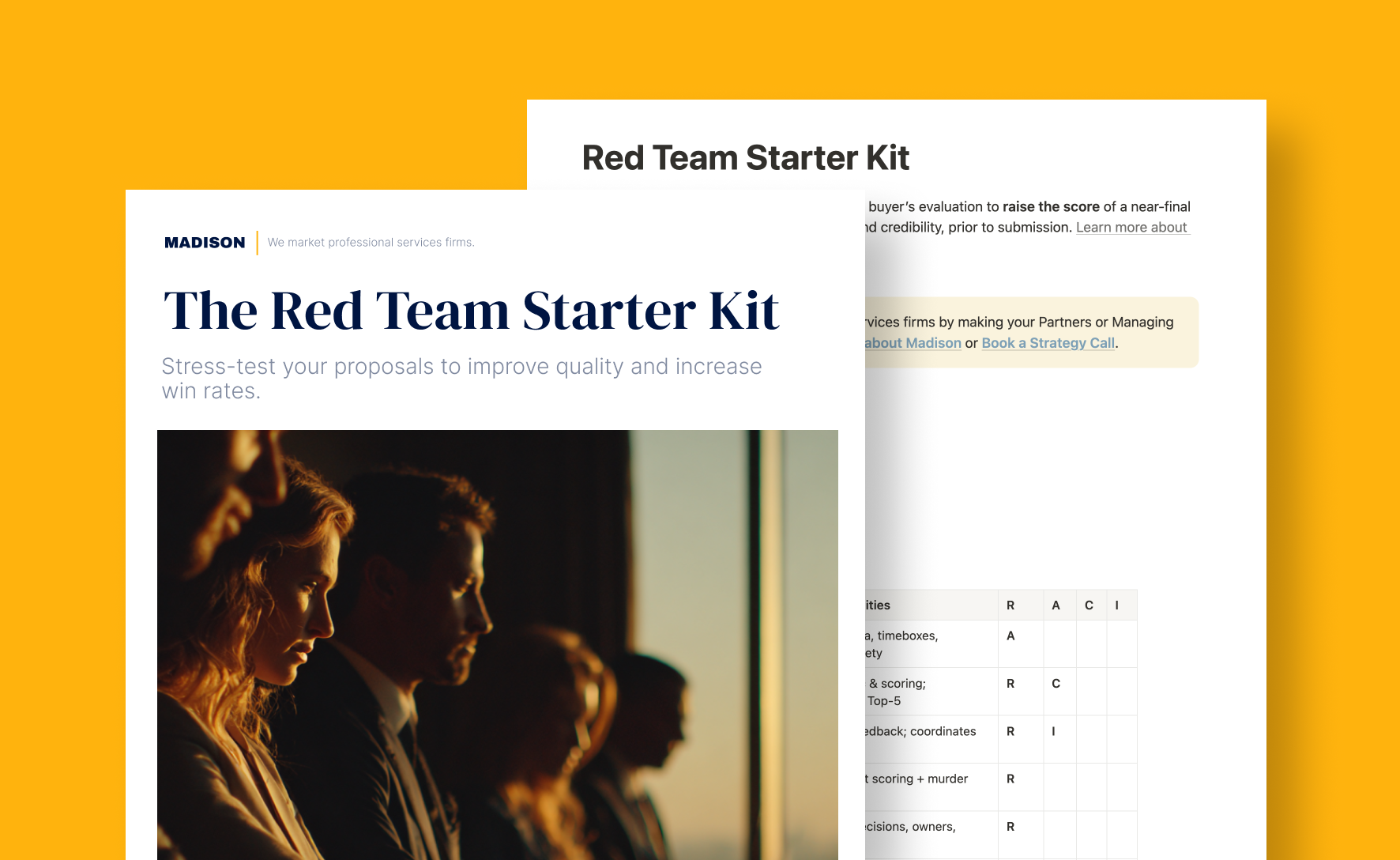In this Article:
Too many proposals die from friendly fire. Too many authors, not enough skepticism. You quickly lose “beginner’s mind”, and no longer see where your proposal might be weak.
A proper Red Team process can fix that. You simulate the buyer, pressure-test the narrative, and conduct dry runs - first internally, then with your champion when you can - to turn a good draft into one that wins.
Here’s how to set up your Red Team process for success:
What a Red Team is(and isn’t)
A Red Team is an independent review that predicts how a near-final proposal would score against the buyer’s criteria. It usually recommends specific improvements to clarity, completeness, and customer focus.
It is not a line-edit or a debate about house style. It is more like a dress rehearsal before opening night.
Ideal Roles for Red Teaming Effectively
If you’re a small team you might not always be able to fill every role. Or folks might have to play multiple roles. But in an ideal world, you’d have the following:
- The Moderator. Runs the agenda, watches time, protects psychological safety when needed.
- Red Team Lead: Owns the scoring rubric, consolidates findings into prioritized changes.
- Blue Team Lead: Typically the proposal owner. They listen, ask clarifying questions, but do not defend.
- Scribe: Captures decisions, assigns owners and due dates.
- Reviewers: 3-5 folks who were not primary authors on the proposal. Ideally at least one of them is an industry SME, and one of them is a delivery/PMO voice.
How to Run Your Red Team Process:
The biggest mistake firms make when trying to red team is not giving themselves sufficient time. You need to run it and be able to make meaningful revisions.
General rule of thumb:
- 7-10 days before submission: Internal Read Team. Content is near-final. It’s okay if design is a little rough, although ideal state you have a Proposal System in place already.
- 3-5 days before submission: Optional second Red Team or champion dry run. Note this isn’t always possible, and RFP processes often don’t allow this.
24 hours prior to each, you’ll want to send the draft of the proposal, with sections labeled by owner. You’ll want to submit the RFP itself and any evaluation criteria if you have it. Lacking this, you’ll want some form of a rubric or compliance matrix in place so they know what to use to evaluate. And you’ll want to include a scoring sheet with any weights included.
The Internal Dry Run
We like to allow for 90-120 minutes for this. A rough agenda might look something like the following:
- Framing: Moderator sets the intent. “We’re simulating the customer. Direct, evidence-based feedback only. We leave with a prioritized fix list.”
- Walkthrough: The team delivers the verbal presentation, or submit the written version to read through.
- Silent score: Each reviewer scores the exec summary and one assigned section independently against the rubric. No discussion yet.
- Q&A: Rapid-fire questioning by reviewers.The goal is to surface weak assumptions, missing proof, and unclear trade-offs - not to wordsmith. (Example questions are included in the Red Team worksheets).
- Selection Committee Simulation: Each reviewer states their overall score and recommendation (award / short-list / no-bid) with a rationale tied to the criteria.
- Debrief: Discuss the top 5 gaps, any quick wins vs. heavy lifts, and make decisions. The Scribe logs the owners and due dates and follows up immediately after.
Ideally, you walk away with a single page that includes the top 5 issues, the fix plan with owners, any narrative changes, risk mitigation callouts, and any design notes (which, assuming you have a proposal system, are also sent to that team for future state consideration.)
The Champion Dry Run
If you have a true internal champion and the process allows it, take advantage. They should be run differently though - a 45–60 minute preview. Goal is candid feedback, not salesy.
Submit the deck prior so they have time to review. If you have time, do a high-level dry run. And then get their feedback. You want to know things like:
- “If your committee read this today, where do you think they would push back?”
- “Which sections or claims trigger risk in your mind (from an IT perspective? Legal? Finance?)”
- “Whose support are we underestimating?”
- “What’s missing for this to be an easy yes?”
If they give you feedback, make sure you take action on it. This stuff is gold.
Pitfalls to Avoid
The most common as we already mentioned is not giving yourself enough time to run the process in the first place. But assuming you do, some others to watch out for:
- You have the wrong people. You don’t want authors reviewing their work. Keep the reviewers independent.
- You don’t have a rubric. You need to guide the reviewers so they can best help you. You want to move beyond taste to mirror the actual buyer’s criteria.
- You use the time to edit. That’s not the purpose. Save for later.
- You get defensive. Don’t argue. It’s their job to poke holes.
- You don’t have an owner. The red team lead takes ownership of the fix plan post-meeting.
A Good Proposal System + Red Teaming = More Wins
Your Proposal System gives you the assets and process. The Red Team is the rehearsal that makes it sing. Treat it like a buyer-scored simulation and when permissible pressure-test the narrative with your champion before you submit. If you do, you’ll move from “good” to “chosen” more often.


